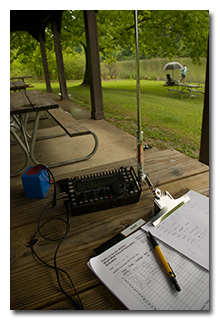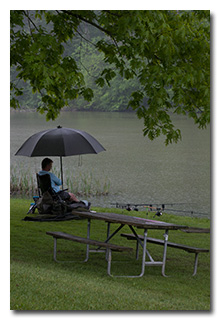
by William Eric McFadden
From the Strouds Run State Park website:
-
Located outside of the city of Athens and within easy driving distance of Ohio University, Strouds Run State Park surrounds Dow Lake and draws a mix of trail and lake users. Miles of hiking, mountain biking, and horseback riding provide scenic views from rugged trails. The lake offers boating, paddling, swimming and a shaded campground.
Pictures
Description
On Saturday, May 13, 2023, one member of the Southeast Ohio Radio Adventure Team performed a successful activation of Strouds Run State Park (K-1994) as part of the Parks on the Air (POTA; link) program.
With the solar numbers not looking dismal, and with the morning weather forecast calling for rain, Eric McFadden, WD8RIF, thought it a perfect morning for a first activation with his Elecraft AX1 antenna.
 Eric arrived at Bulldog Shelter at about 1420 UTC and, finding it entirely unoccupied except for a
lone fisherman sitting lakeside under an umbrella, chose a picnic table within the metal-roofed
shelter house and deployed his Elecraft KX3 transceiver and brand-new Elecraft AX1 antenna. Eric
was on the air at 1430 UTC.
Eric arrived at Bulldog Shelter at about 1420 UTC and, finding it entirely unoccupied except for a
lone fisherman sitting lakeside under an umbrella, chose a picnic table within the metal-roofed
shelter house and deployed his Elecraft KX3 transceiver and brand-new Elecraft AX1 antenna. Eric
was on the air at 1430 UTC.
As he had expected, Eric found he had good cell-signal at this location and would be able to spot himself on the POTA Spots website and to use POTA Spots to identify possible Park-to-Park (P2P) QSOs. He was pleased to see that a majority of the CW POTA spots were showing activations to be on 20, 17, and 15m—a good sign given that the AX1 covers only those bands.
Eric began his operation on 20m by finding himself a frequency to run and calling "CQ POTA", and was pleased to be auto-spotted on POTA Spots. However, in a sign that propagation conditions weren't what he might have hoped, Eric called "CQ POTA" for nine minutes before receiving his first response, and during this nine minute period, he noticed that most of the other CW POTA activators had abandoned the higher HF bands in favor of 40m, a band the AX1 doesn't cover without the 40m extension-coil that Eric doesn't yet have. Eric's first QSO came at 1439 UTC with WI0S in Minnesota. QSOs came slowly, with Eric's sixth QSO coming at 1450 UTC with K5PE in Texas. This run included a two-fer P2P QSO with WI5D who was activating Lewis and Clark National Historic Trail (K-4572) and Benedictine Bottoms State Wildlife Area (K-7867) in Kansas, and QSOs with operators located in Minnesota (2), Florida, California, Kansas, and Texas. In the middle of this run, the rain began to fall hard, and Eric was glad he was protected by the roof of the picnic shelter.
After eight additional minutes of calling on 20m produced no QSOs, Eric switched to 17m, but ten minutes of calling there produced no QSOs. Switching to 15m, Eric called "CQ POTA" there for five minutes, with no responses.
Checking POTA Spots for P2P QSO opportunities, at 1527 UTC Eric made a P2P QSO on 20m with KB3A who was activating Turkey Creek Nature Preserve State Conservation Area (K-3709) in Alabama.
 Finding himself a frequency to run on 20m, at 1532 UTC, Eric made a QSO with N4CD who was extremely
strong in Oklahoma.
Finding himself a frequency to run on 20m, at 1532 UTC, Eric made a QSO with N4CD who was extremely
strong in Oklahoma.
Pausing again to check for P2P QSO opportunities, at 1538 UTC Eric made another P2P QSO on 20m with WI5D, who was this time activating Lewis and Clark State Park (K-1770) in Missouri.
Returning to run a frequency on 20m, at 1549 UTC Eric made a QSO with KZ5W in Texas, at 1551 UTC he made a QSO with K5LDA in Alabama, and at 1555 UTC he made a QSO with K5SJC in Colorado.
In all, Eric logged thirteen QSOs, with four P2P QSOs, all on 20m, in eighty-five minutes of on-air time. All of Eric's QSOs were CW and were made at five watts output.
While Eric was disappointed it took so long to validate his activation using the compromise AX1 antenna, he recognized that much of the reason it took so long was that HF propagation conditions were terrible despite what the raw solar numbers might have been indicating. Eric was pleased with how quickly the AX1 could be deployed, and he was very pleased at being able to have himself and his entire station under-roof in the picnic shelter during the at-times heavy rain. The time spent calling CQ also allowed Eric to enjoy the calls of bullfrogs in the rushes in the lake and to enjoy watching a heron, red-wing blackbirds, and barn swallows.
Eric also submitted his log to the World Wide Flora and Fauna in Amateur Radio (WWFF; link) program for an activation of Strouds Run State Park, KFF-1994.
(return)